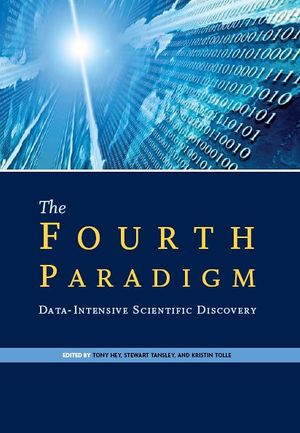The Fourth Paradigm: Data-Intensive Scientific Discovery : Différence entre versions
De Artist
imported>Jacques Ducloy |
imported>Jacques Ducloy (→Introductions) |
||
| Ligne 9 : | Ligne 9 : | ||
::Gordon Bell (Microsoft Research) | ::Gordon Bell (Microsoft Research) | ||
*Jim Gray on eScience: a transformed scientific method, [http://research.microsoft.com/en-us/collaboration/fourthparadigm/4th_paradigm_book_jim_gray_transcript.pdf] | *Jim Gray on eScience: a transformed scientific method, [http://research.microsoft.com/en-us/collaboration/fourthparadigm/4th_paradigm_book_jim_gray_transcript.pdf] | ||
| − | ::''Cette partie reprend un manuscrit de Jim Gray, utilisé lors de sa dernière communication, le 11 janvier 2007, au Computer Science and Telecommunications Board<ref>http://research.microsoft.com/en-us/ | + | ::''Cette partie reprend un manuscrit de Jim Gray, utilisé lors de sa dernière communication, le 11 janvier 2007, au Computer Science and Telecommunications Board<ref>http://research.microsoft.com/en-us/um/people/gray/talks/NRC-CSTB_eScience.ppt</ref>.'' |
::Edition réalisée par Tony Hey, Stewart Tansley, and Kristin Tolle | ::Edition réalisée par Tony Hey, Stewart Tansley, and Kristin Tolle | ||
Version du 24 mai 2011 à 11:38
The Fourth Paradigm: Data-Intensive Scientific Discovery est le nom d'un ouvrage collectif édité par Tony Hey, Stewart Tansley, et Kristin Tolle en hommage à Jim Gray.
Cet ouvrage est commercialisé sous forme papier et en libre accès sur l'Internet. Il donner une suite aux réflexions de Jim Gray autour du quatrième paradigme de la science.
Sommaire
Le sommaire
Introductions
- Avant-propos / Foreword / [1]
- Gordon Bell (Microsoft Research)
- Jim Gray on eScience: a transformed scientific method, [2]
- Cette partie reprend un manuscrit de Jim Gray, utilisé lors de sa dernière communication, le 11 janvier 2007, au Computer Science and Telecommunications Board[1].
- Edition réalisée par Tony Hey, Stewart Tansley, and Kristin Tolle
Partie 1 : La Terre et l'environnemnt
- Part 1: Earth and Environment
- Introduction
- Dan Fay
- Gray’s laws: database-centric computing in science
- Alexander S. Szalay, José A. Blakeley
- The emerging science of environmental applications: Jeff Dozier, William B. Gail
- Redefining ecological science using data:James R. Hunt, Dennis D. Baldocchi, Catharine van Ingen
- A 2020 vision for ocean science :John R. Delaney, Roger S. Barga
- Bringing the night sky closer: discoveries in the data deluge: Alyssa A. Goodman, Curtis G. Wong
- Instrumenting the earth: next-generation sensor networks and environmental science Michael Lehning, Nicholas Dawes, Mathias Bavay, Marc Parlange, Suman Nath, Feng Zhao
Part 2: Health and Wellbeing
- Introduction
- Simon Mercer
- The healthcare singularity and the age of semantic medicine
- Michael Gillam, Craig Feied, Jonathan Handler, Eliza Moody, Ben Shneiderman, Catherine Plaisant, Mark Smith, John Dickason
- Healthcare delivery in developing countries: challenges and potential solutions
- Joel Robertson, Del DeHart, Kristin Tolle, David Heckerman
- Discovering the wiring diagram of the brain
- Jeff W. Lichtman, R. Clay Reid, Hanspeter Pfister, Michael F. Cohen
- Toward a computational microscope for neurobiology
- Eric Horvitz, William Kristan
- A unified modeling approach to data-intensive healthcare
- Iain Buchan, John Winn, Chris Bishop
- Visualization in process algebra models of biological systems
- Luca Cardelli, Corrado Priami
Part 3: Scientific Infrastructure
- Introduction Daron Green
- A new path for science? Mark R. Abbott
- Beyond the tsunami: developing the infrastructure to deal with life sciences data
- Christopher Southan, Graham Cameron
- Multicore computing and scientific discovery
- James Larus, Dennis Gannon
- Parallelism and the cloud
- Dennis Gannon, Dan Reed
- The impact of workflow tools on data-centric research
- Carole Goble, David De Roure
- Semantic escience: encoding meaning in next-generation digitally enhanced science
- Peter Fox, James Hendler
- Visualization for data-intensive science
- Charles Hansen, Chris R. Johnson, Valerio Pascucci, Claudio T. Silva
- A platform for all that we know: creating a knowledge-driven research infrastructure
- Savas Parastatidis
Part 4: Scholarly Communication
- Introduction Lee Dirks
- Jim Gray’s fourth paradigm and the construction of the scientific record Clifford Lynch
- Text in a data-centric world Paul Ginsparg
- All aboard: toward a machine-friendly scholarly communication system
- Herbert Van de Sompel, Carl Lagoze
- The future of data policy
- Anne Fitzgerald, Brian Fitzgerald, Kylie Pappalardo
- I have seen the paradigm shift, and it is us John Wilbanks
- From web 2.0 to the global database Timo Hannay
Final Thoughts
- The way forward Craig Mundie
- Conclusions and Next Steps
- Tony Hey, Stewart Tansley, Kristin Tolle
Voir aussi
Liens externes
- Le site The Fourth Paradigm Home, qui donne accès à la totalité de l'ouvrage.
